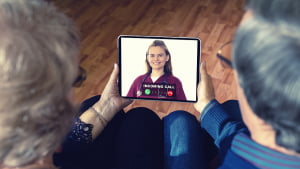Care At A Distance Thanks To Technology
 The pandemic has had an impact on all aspects of life and many changes are expected to be seen over the coming months and years as a result of the coronavirus crisis.
The pandemic has had an impact on all aspects of life and many changes are expected to be seen over the coming months and years as a result of the coronavirus crisis.
And healthcare leaders are now working towards ensuring that a lasting legacy is left behind, with the rapid changes that have been seen across the NHS in the last few months firmly embedded in how the service is run.
According to a report in the Financial Times, the NHS has become a lot more collaborative and technology-focused, developments that could be built on in the near future to improve patient experiences and make better use of resources.
One way that the pandemic is expected to change the health service is by providing care at a distance – with consultations taking place without people having to visit their hospital or a local surgery. This doesn’t even require any sophisticated technology, with doctors saying that they’re doing calls over the phone, via text and email, as well as video chats.
Chief executive of Yeovil District Hospital Jonathan Higman, for example, explained that before the pandemic, the majority of outpatient appointments were carried out in person but 70 per cent are now done through remote contact using video technology and smartphones.
He also went on to say that there is now a “massive opportunity in using wearable technology to monitor patients”, especially for those more vulnerable and who have had to shield through the crisis.
Wearable technology is clearly coming to the forefront more and more, with the likes of the Apple Watch 4 and 5 both having the ability to carry out electrocardiograms using an ECG app, while other models on the market can monitor the wearer’s blood pressure.
Hearable tech is also becoming more sophisticated, with some products available that can monitor heart rates, body temperature and both brain and physical activity.
While this has benefits for the health service, it also has benefits for patients as well, helping them to feel more in control of their condition and how to manage it.
Recent research from Siemens Financial Services highlighted telemedicine as one of the top areas for investment in the healthcare sector in the UK, as well as a new generation of digitalised and mobile diagnostics, and smart digitised hospitals.
The report emphasised the fact that remote access and communication isn’t just about connecting geographically distant patients with doctors, but also about linking hardware with both systems and clinical professionals.
Some £1.4 billion will need to be spent by healthcare organisations in the UK over the next five years in order to drive this kind of innovation, it was further noted.
For help with medical image management, get in touch with CIMAR today.